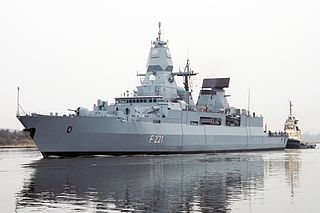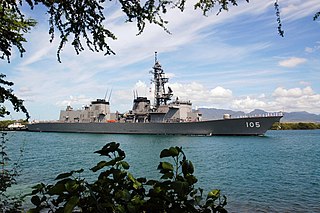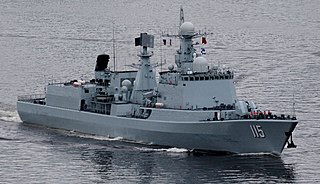
In naval terminology, a destroyer is a fast, maneuverable, long-endurance warship intended to escort larger vessels in a fleet, convoy, or carrier battle group and defend them against a wide range of general threats. They were originally conceived in 1885 by Fernando Villaamil for the Spanish Navy as a defense against torpedo boats, and by the time of the Russo-Japanese War in 1904, these "torpedo boat destroyers" (TBDs) were "large, swift, and powerfully armed torpedo boats designed to destroy other torpedo boats". Although the term "destroyer" had been used interchangeably with "TBD" and "torpedo boat destroyer" by navies since 1892, the term "torpedo boat destroyer" had been generally shortened to simply "destroyer" by nearly all navies by the First World War.

Blohm+Voss (B+V), also written historically as Blohm & Voss, Blohm und Voß etc., is a German shipbuilding and engineering company. Founded in Hamburg in 1877 to specialise in steel-hulled ships, its most famous product was the World War II battleship Bismarck. In the 1930s, its owners established the Hamburger Flugzeugbau aircraft manufacturer which, shortly before the outbreak of World War II, adopted the name of its parent company. Following a difficult period after the war, B+V was revived, changing ownership among several owners, as Thyssen Group and Star Capital. In 2016, it became a subsidiary of Lürssen and continues to supply both the military and civilian markets. It serves two areas – new construction of warships as NVL B.V. & Co. KG, and new construction and refitting of megayachts. The company has been in operation, building ships and other large machinery, almost continuously for 147 years.

The Type 051 destroyer was a class of guided missile destroyers based on the hull of the Soviet Neustrashimy-class destroyer deployed by China. It was the first guided missile destroyer fielded by the People's Liberation Army Navy (PLAN), and the first designed and built in China. 17 were built from 1970 to 1990; it was not until the 21st century that China would again build a class in such large numbers.
Aktien-Gesellschaft Vulcan Stettin was a German shipbuilding and locomotive building company. Founded in 1851, it was located near the former eastern German city of Stettin, today Polish Szczecin. Because of the limited facilities in Stettin, in 1907 an additional yard was built in Hamburg. The now named Vulcan-Werke Hamburg und Stettin Actiengesellschaft constructed some of the most famous civilian German ships and it played a significant role in both World Wars, building warships for the Kaiserliche Marine and the Kriegsmarine later.

The F124 Sachsen class is the German Navy's latest class of highly advanced air-defense frigates. The design of the Sachsen-class frigate is based on that of the F123 Brandenburg class but with enhanced stealth features designed to deceive an opponent's radar and acoustic sensors. The class incorporates an advanced multifunction radar APAR and a SMART-L long-range radar which is purported to be capable of detecting stealth aircraft and stealth missiles.

The Type 101 Hamburg class was the only class of destroyers built during post-war Germany. They were specifically designed to operate in the Baltic Sea, where armament and speed is more important than seaworthiness. They were named after Bundesländer of West Germany.
H. C. Stülcken Sohn was a German shipbuilding company located in Hamburg and founded in 1846 by Heinrich Christoph Stülcken.

The Almirante Brown class is a class of warships built for the Argentine Navy. They were commissioned between 1983 and 1984, after the Falklands War. The class comprises four ships; Almirante Brown, La Argentina, Heroína and Sarandí. They are classified as either frigates or destroyers by different publications. The MEKO 360 type warships are based on modular designs which allow quick changes to the vessel's armaments depending on mission requirements. The modular nature of the construction also allows the ships to be modernized or refitted with greater ease. Six vessels were initially ordered, however two ships were cancelled and replaced with orders for MEKO 140 type hulls.

The Espora-class corvettes are six warships of the Argentine Navy built in Argentina to the German MEKO 140A16 design, this in turn being based on the Portuguese João Coutinho-class project. The first entered service in 1985 but accidents and lack of funds meant the last was not completed until 2004. The ships currently form the 2nd Corvette Division of the Argentine Navy and their home port is the Puerto Belgrano Naval Base. Although considered by its designers to be frigates, the Espora-class vessels have been classed in Argentina as corvettes.
The improved Grom-class destroyers of 1939 were the third and fourth planned ships of the Grom class of destroyers ordered for the Polish Navy shortly before World War II. They were to be built in Poland, the first destroyers so constructed, and were to be named Huragan ("hurricane") and Orkan ("windstorm"), respectively. Their design included greater power and displacement than the first two ships of the class. Their construction was interrupted by the beginning of World War II and they were never completed.
Several naval ships of Germany were named Hessen after the state of Hesse, Germany :

Hamburg(D181) was the lead ship of the Hamburg-class destroyer of the German Navy.

Schleswig-Holstein(D182) was the second ship of the Hamburg-class destroyer of the German Navy.

Bayern(D183) was the third ship of the Hamburg-class destroyer of the German Navy.

JS Inazuma (DD-105) is the fifth ship of Murasame-class destroyers. She was commissioned on 15 March 2000.

Shenyang (115) is the lead ship of Type 051C destroyer of the People's Liberation Army Navy. She was commissioned on 1 January 2006.

Shijiazhuang (116) is second ship of Type 051C destroyer of the People's Liberation Army Navy. She was commissioned on 22 January 2007.

Sovremenny was the lead ship of Sovremenny-class destroyers of the Soviet and later Russian navy.

Otchayanny was a Sovremenny-class destroyer of the Soviet and later Russian navy.

Otlichny was a Sovremenny-class destroyer of the Soviet and later Russian navy.




















